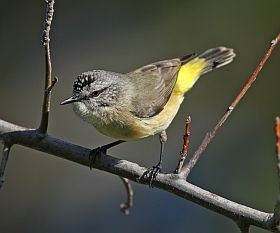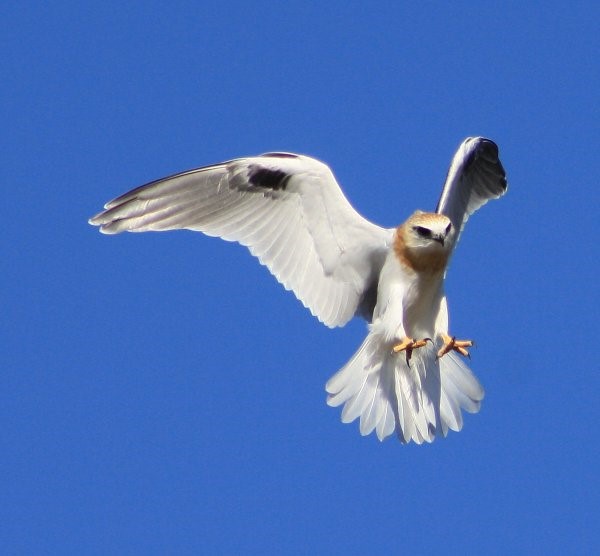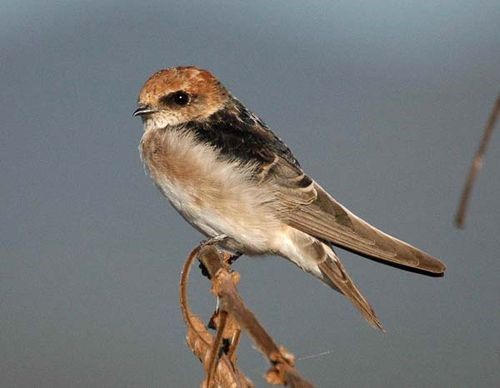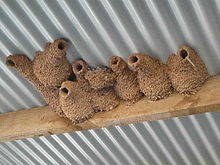One of the many curiosities of our neighbourhood birds, is our lack of understanding of their nomadic behaviour. But modern technology is starting to give us clues. By placing tiny chips into bird’s bodies, it is allowing bio-scientists to not only monitor their movements but build a picture of their life patterns. Melbourne University’s myswan.org is already involved in ground breaking research of the Black Swan.
In the Sanctuary Lakes neighbourhood there are numerous nomadic visitors, some who annually stop here for just a few days, others that make four or five visits a year, some arriving as small families, with others as large flocks. For this month’s Rubik I have chosen three very regular native Australian visitors, each with their own story for enjoying the delights of our neighbourhood.
First up, the sparrow sized and distinctive coloured Yellow-rumped Thornbill.

Yellow-Rumped Thornbill Acanthiza chrysorrhoa
A small family of about half a dozen Yellow Rumps are visiting us and can be seen presently around the bushes and native vegetation near the maintenance sheds and at the bottom of the driving range. A relatively small bird at approximately 9.5–12 cm in length; but as the name would suggest it has a very eye catching, striking, bright yellow rump and a distinctive black forehead with white spots. There is a thin white line above the eye, a whitish throat, grey head and neck. It has a short tail with a long slender black bill. The belly is white with light buff below the wings. The wings are grey and the tail is black.
Yellow Rumps mainly feed on the ground, moving in a series of jerky hops picking up insects, spiders, caterpillars and occasional seeds all of which is readily available in our Green Spaces. When fly hopping the tail is frequently fanned briefly exposing the yellow rump.
Hopefully our visiting Yellow Rumps are here to breed, which takes place between July and December. One female forms a breeding group with several males and this co-operative can raise up to four broods in a good season. The Yellow Rump’s nest is very unusual. A small untidy structure of grass and bark on two levels: an upper 'false' cup-shaped nest and a lower, domed, nest-chamber with a hooded entrance. The function of the false nest is not clearly understood, with many theories being put forward, such as: deterring predators, a roosting place for male or fledglings, a 'practice' nest for the helpers or as a 'displacement' activity for males. Whatever the reason the nest only lasts one brood so the co-operative is constantly nest building during the breeding season.
The Yellow Rumps are regular visitors but they are also common nomads in our area’s shrublands, along the watercourses, in parks and gardens.
Our second regular Aussie visitor is the small bird of prey, the Black-shouldered Kite.

Black-shouldered Kite Elanus axillaris
A pair of Black-shoulder Kites have been staying with us for the past six to eight weeks. They have been seen from Skeleton Creek through Breezewater and up past the maintenance sheds to the starter’s hut area. They have also been seen around the driving range and the green space between Pinnacle and the lake.
For a bird of prey Black Shoulders are relatively small, measuring around 35 cm in length with a wingspan of 80–100 cm. Adults have predominantly grey-white plumage and prominent soft reddish-brown markings on its head above its dark red eyes. The nostrils are yellow, as are its legs and feet. It gains its name from the distinctive black patches on its wings. It has a direct flight with quick shallow wing beats interspersed with glides on upswept wings (like a seagull), and is often seen hovering, with feet dangling.
Black-shoulder Kites feed mainly on rodents and small mammals, particularly mice, rats, young. rabbits and hares, often following rodent plagues in agricultural areas. It will also eat lizards, snakes and larger insects such as grasshoppers. It prefers to hunt during the day, particularly early morning and late afternoon, often hovering with its wings held upright in a V-shape, before dropping down and grabbing prey with its talons. Prey items are eaten while flying or on a perch, which can be a high tree or an artificial structure like our boulevard light poles.
Black-shoulders are nomadic following their rodent food supply and enjoy living in grasslands, wastelands and coastal areas.
Breeding season is from August to December, therefore like the Yellow Rump family it is hoped that the pair presently visiting us might look to breeding here. Nests are a platform of sticks 27-45 cm across, lined with green leaves, bark or fur, usually hidden in the canopy of a living tree, or occasionally an artificial structure. Three to four eggs are laid, and hatch after a month. Juvenile birds are dependent for a month and then often disperse widely (up to 1000 km).
Our third regular Aussie visitor can be described as both nomadic and migratory. Over the past few years in flocks of over fifty birds, it has regularly visited Sanctuary Lakes for a few weeks in late August September and then again in February March. It is also known to take a short minor migration to northern NSW and Southern Queensland in the winter months. This little traveller is the Fairy Martin.

Fairy Martin (Petrochelidon arie
The best description of the Fairy Martin was a Sanctuary Lake’s neighbour who told me there was a large flock on a fairway of what he thought were Swallows but on closer inspection they obviously had different markings.
The Fairy Martin is slightly smaller (12cms) than the Welcome Swallow (15cms), with darker wings, a whitey-brown underbody and a pinkish-red head whereas the Swallow has its pinkish red colour under its beak and above its white breast. The Fairy Martin has a short, slightly forked tail that appears square in flight. They feed on flying insects that they catch on-the-wing high in the air column. It is gregarious, feeding in large flocks and nesting in colonies. It enjoys open green spaces and being close to water.
The Fairy Martin is sometimes called the Bottle Swallow, because its nest, made from tiny pellets of mud or clay, is bottle shaped. The nests are often placed in colonies in culverts, roof eves or under bridges. The entrance to each nest is via the horizontal spout.

Fairy Martin’s bottle nests
Although our bio-scientist are building a picture of our nomadic Aussie visitors, it is hoped that with the new chip technology they will be able to tell us the who’s, the whys and where-fore’s of our regular Aussie visitors.